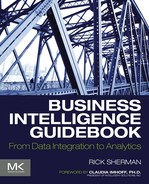Table of Contents
Chapter 1. The Business Demand for Data, Information, and Analytics
Too Much Data, Too Little Information
Data Capture versus Information Analysis
Common Terminology from our Perspective
Part II. Business and Technical Needs
Chapter 2. Justifying BI: Building the Business and Technical Case
Developing Scope, Preliminary Plan, and Budget
Chapter 3. Defining Requirements—Business, Data and Quality
The Purpose of Defining Requirements
Defining Requirements Workflow
Part III. Architectural Framework
Chapter 4. Architecture Framework
The Need for Architectural Blueprints
Avoiding Accidents with Architectural Planning
Do Not Obsess over the Architecture
Chapter 5. Information Architecture
The Purpose of an Information Architecture
Operational BI versus Analytical BI
The Purpose of a Data Architecture
Data Workflow—Rise of EDW Again
Chapter 7. Technology & Product Architectures
Where are the Product and Vendor Names?
Product and Technology Evaluations
Chapter 8. Foundational Data Modeling
Definitions—The Difference Between a Data Model and Data Modeling
Entity-Relationship (ER) Modeling Overview
Limits and Purpose of Normalization
Chapter 9. Dimensional Modeling
Introduction to Dimensional Modeling
High-Level View of a Dimensional Model
Entity Relationship versus Dimensional Modeling
Purpose of Dimensional Modeling
Chapter 10. Business Intelligence Dimensional Modeling
Too Few or Too Many Dimensions
Part V. Data Integration Design
Chapter 11. Data Integration Design and Development
Getting Started with Data Integration
Chapter 12. Data Integration Processes
Introduction: Manual Coding versus Tool-Based Data Integration
Part VI. Business Intelligence Design
Chapter 13. Business Intelligence Applications
BI Design Layout—Best Practices
Data Design for Self-Service BI
Matching Types of Analysis to Visualizations
Chapter 14. BI Design and Development
Chapter 15. Advanced Analytics
Advanced Analytics Overview and Background
Predictive Analytics and Data Mining
Chapter 16. Data Shadow Systems
Are There Data Shadow Systems in Your Organization?
What Kind of Data Shadow Systems Do You Have?
The Evolution of Data Shadow Systems in an Organization
Damages Caused by Data Shadow Systems
The Benefits of Data Shadow Systems
Moving beyond Data Shadow Systems
Misguided Attempts to Replace Data Shadow Systems
Renovating Data Shadow Systems
Chapter 17. People, Process and Politics
The Business and IT Relationship
Chapter 18. Project Management
The Role of Project Management
Chapter 19. Centers of Excellence
The Purpose of Centers of Excellence
Data Integration Center of Excellence
